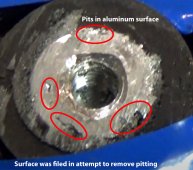Nickel plated bus bars of typical size of 2 mm thick, 20 mm wide have about 0.07 milliohms of resistance.
A proper battery terminal to bus bar clamping connection has about 0.05 milliohm.
Total is 0.05 + 0.07 + 0.05 = 0.17 milliohm for battery terminal to battery terminal connection resistance.
At 100 amps of current that is 100A^2 * 0.17 milliohms = 1.7 watts of heating. This is barely warm to touch with 25 degs ambient air temp.
Problem is many folks make poor battery terminal connections and the terminal connection resistance can be greater than 0.2 milliohms.
With 0.2 milliohm terminal connections there is 0.2 + 0.07 + 0.2 = 0.47 milliohms.
At 100 amps that is 100A^2 * 0.47 milliohms = 4.7 watts of heating. This will have a hot temperature.
Aluminum grows a protective surface coating of aluminum oxide which is an insulator. You must clean this off before attaching bus bars.
50%-50% mix of white vinegar and water, followed by isoprophyl alcohol cleaning will clean off aluminum oxide. Keep vinegar away from threads and keep fingers off of cleaned terminals. Aluminum oxide grows back quickly so as soon as terminal dries off attach and clamp down bus bar.
Use nickel plated copper core bus bars. The nickel plating provides an inter-metalic barrier between aluminum and copper. Beware of getting brass core bus bars which have 4x the resistance of copper core bus bars. You can file off the end of bus bar plating to check. Brass is brighter yellowish color compared to copper's brownish color.
Do not use bare unplated copper for bus bars or cable terminal lugs. It interacts with aluminum over time, eating away aluminum surface. NoOxy grease will help prevent interaction, but better not to use bare copper.
The below picture of aluminum cell terminal had bare unplated copper bus bars. The scratching in picture was an attempt to file out the surface pits in aluminum terminal.





